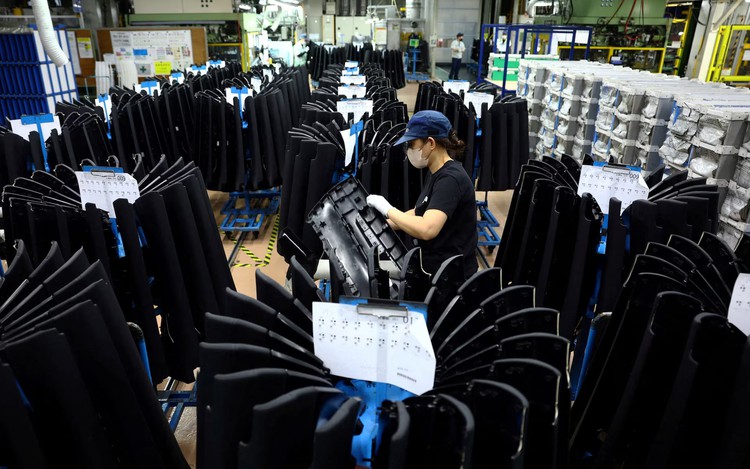
An employee works on the assembly line at Nanjo Auto Interior, a manufacturer of inside door panels and other parts for Mazda Motor, in Akitakata, Hiroshima Prefecture, Japan July 14, 2025. Photo: Reuters
Shipments from automakers in particular plummeted, following a period of hiking exports before tariffs came into effect.
"The contraction is largely due to one-time factors such as housing investment" affected by regulatory change, said economist Kazutaka Maeda at Meiji Yasuda Research Institute.
"Exports also reacted," he said. "Overall, the economy lacks strong underlying momentum, but the trend still points to a gradual recovery over the next year or two."
Economists generally viewed this quarter's GDP figures as having a marginal impact on Bank of Japan thinking when next deciding interest rates versus factors such as inflation. However, an economist close to Prime Minister Sanae Takaichi gave the data more weight.
Given the contraction, it "would be misguided for the BOJ to decide to raise interest rates" in December, Credit Agricole chief Japan economist Takuji Aida, who is on Takaichi's flagship panel tasked with laying out the country's growth strategy, said in a report to clients.
Automakers combat tariffs with price cuts
Gross domestic product contracted 1.8% in July-September. That compared with revised growth of 2.3% in the previous three-month period, as well as the 2.5% contraction that economists on average estimated in a Reuters poll.
The reading also translated into a quarterly contraction of 0.4% versus the median estimate of 0.6%.
Exports constituted the main drag as the impact of higher U.S. tariffs intensified. Automakers saw shipment volume plunge, reversing earlier front-loaded exports ahead of tariff hikes, though they mostly absorbed tariffs by cutting prices.
Net external demand, or exports minus imports, knocked 0.2 of a percentage point off growth, versus a 0.2 point positive contribution in April-June.
The U.S. and Japan formalised an agreement in September that implemented a baseline 15% tariff on nearly all Japanese imports, versus an initial 27.5% on autos and 25% for most other goods.
Private consumption matches estimates
Housing investment also weighed on growth as tighter energy-efficiency regulation introduced in April slowed commitments.
Private consumption, which accounts for over half of economic output, grew 0.1%, matching a market estimate. That was cooler than the 0.4% of the second quarter, indicating that high food costs increased reluctance to spend.
Capital spending, another key driver of private demand-led growth, rose 1.0% in the third quarter, far exceeding a market estimate of 0.3%.
"Private consumption rose for the sixth straight quarter, and capital expenditure increased for the fourth consecutive quarter," Minoru Kiuchi, the economic revitalisation minister, said in a statement.
"This reinforces our view that the economy remains on a moderate recovery path," he said.
Private-sector estimates reflect expectation for growth to rebound in October-December. A poll of 37 economists by the Japan Center for Economic Research projected a 0.6% expansion.
The weak GDP data comes as Takaichi's government compiles a stimulus package to help households manage rising living costs.
Advisers to Takaichi have cited a likely sharp GDP contraction as a reason for aggressive stimulus measures.
Finance Minister Satsuki Katayama told reporters on Sunday that proposed economic stimulus would exceed 17 trillion yen ($109.94 billion), media reported.
"From late this winter through around spring, there will be measures that improve households' income conditions in real terms," said Nomura Securities economist Uichiro Nozaki. "Therefore, in terms of underpinning consumption in the first half of next year, this is a positive factor."
($1 = 154.6300 yen)




Max: 1500 characters
There are no comments yet. Be the first to comment.